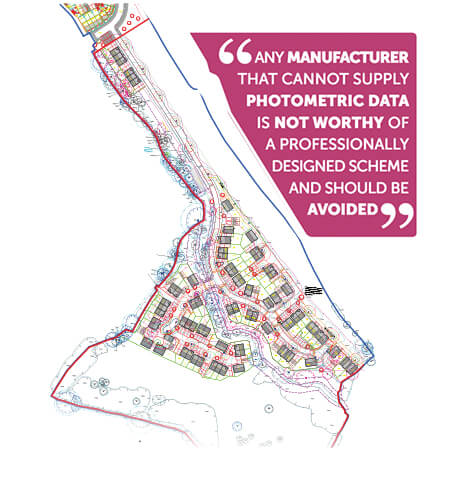All Things Bright And Beautiful
 When designing lighting for sensitive commercial landscape areas, there’s a lot to consider.
When designing lighting for sensitive commercial landscape areas, there’s a lot to consider.
Defining what ‘sensitive’ means in the first place can be tricky.
From a lighting perspective, it generally means the following:
- Endangered ecology receptors such as
bats, newts, birds, badgers etc. - Areas of Outstanding Natural Beauty
(ANOB) where a dark vista is preferred. - Residential receptors located near a new
installation that may be negatively affected
by increases in light.
The big question you should always start with is: ‘should I light the space at all?’ Once you’ve determined that lighting is required for people’s health and safety, the design process can move forward. Next you will have to determine the area of sensitivity you’re contending with, and how best to approach it without negatively impacting the receptors.
It’s possible to ease any planning concerns or client worries because modern well designed lighting can provide mitigation for the above receptors without fail. This is, of course, if you start the design process by employing a competent lighting designer as assessed under the Institution of Lighting Professionals (ILP) competency guidance document.
Once you have a lighting designer on board, the next key stage is to get the planners and client to agree on the areas of sensitivity and earmark those for lighting at a level of 1 lux or less (depending on the receptor this may need to be as low as 0.5 lux). This way, you can ensure the design will maintain dark foraging routes, breeding grounds, roosting locations and contain any light to the key areas without unnecessary bright spots. It also gives you clear guidance as to where to place your landscape features so that they can be lit, but not cause the receptors any harm. Where light is needed close to sensitive areas it may be required to plant tall, quick-growing plants to provide shielding.
Upward light (sky glow) should now be almost eradicated from new designs. New luminaire technology and the use of LED means that optics are more precise than at any time in the past. Light can now be placed where required and not just scattered by the lamp within a large optic. So unless you are planning to point light sources directly upwards without any structure to contain it, then light ought to remain only where desired.
Quality optics with published photometric outputs should be the only kind of luminaires used in any space. Any manufacturer that cannot supply photometric data is not worthy of a professionally designed scheme and should be avoided.
Once you start your design, think about what will go where and how it might be lit to enhance the landscape’s best features. Work with your lighting designer early on so that collaboration can remove any location issues, and be mindful of how light behaves and what planting decisions might hinder the design process.
If you position a tree as a key feature in the space, why is it there? Perhaps it’s a visual cue for visitors to transverse the space, or something to aim for to provide shade in the daytime. But what about at night? Thinking about their initial viewpoint and what impression you wish to make should be high on your priority list to ensure your vision is realised.
If it’s impact you want, can you do that from the ground? Should it be within the tree? Could a nearby building be a suitable location for a floodlight with a tight beam to highlight an important feature? Will it be too close to the boundaries which should remain dark? Or could it bounce light upwards and disturb foraging routes or provide sky glow?
All of these concerns can be overcome with a collaborative approach before the planners have taken your design and cast it in stone. After it becomes a planning constraint, it’s too late for full mitigation to take place and often results in all parties struggling to make a design work.
So the bottom line is remember to collaborate early with competent professionals and be mindful from the start about how light behaves. Making the space an appropriately bright and beautifully landscaped area that doesn’t negatively affect the creatures, be they great or small, is something both sides of the design fence want. Let’s make 2017 the year these collaborations really start to happen.

